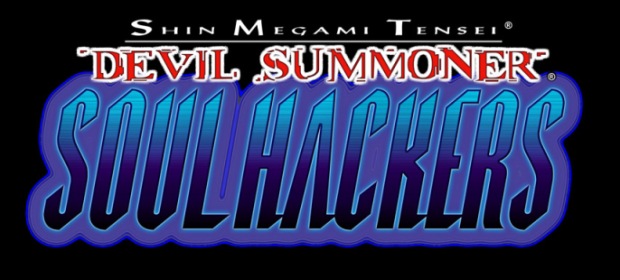The demons that populate Amami City sure are a whimsical lot. Sure, some just shout in full capital letters and threaten to munch your face off, but one asked me why I thought God created humans. I told the barely dressed hell spawn that I thought he was “bored”, assuming it would play to her pagan roots, but instead of joining my team she commented that she hated my forced arrogance and threatened to munch my face off anyway. At least I sort of asked for that one…
Being able to talk to your enemies is an interesting mechanic, and a large part of Soul Hacker’s allure lies in the game’s frequent deceptions and twists on the norm. Make no mistake, this PS1/Saturn re-make is a largely understated port job (aside from the huge addition of full voice acting and a nice demon-rearing StreetPass feature) that carries many hallmarks and blotches of the era, but its core mechanics are just so utterly, utterly compelling that, still now, it’s a hard game to ignore.
 Narratively it’s quite the typical post-Snow Crash, late-nineties Internet fear piece. You play as a member of “The Spookies”, a hacker group that lives in Amami City. The city is a hub of the future, with PC terminals spread throughout the city and a lot of technology given to residents absolutely free. To go alongside this, the city has recently had a “game” called Paradigm X set up which acts as a second life for the residents of the city, letting them visit shops and play in a casino as if it were a real world. It’s not long before you get mixed up with The Phantom Society, and start to discover the truth behind Paradigm X…
Narratively it’s quite the typical post-Snow Crash, late-nineties Internet fear piece. You play as a member of “The Spookies”, a hacker group that lives in Amami City. The city is a hub of the future, with PC terminals spread throughout the city and a lot of technology given to residents absolutely free. To go alongside this, the city has recently had a “game” called Paradigm X set up which acts as a second life for the residents of the city, letting them visit shops and play in a casino as if it were a real world. It’s not long before you get mixed up with The Phantom Society, and start to discover the truth behind Paradigm X…
In many ways the tale is painfully schlocky, but when you factor in a proud Gurkha that summons demons through a magical Saxophone, a female sidekick who’s part demon and part not, and the way your hacker team paints its logo on the side of its mobile base like some sort of Matrix-style Scooby Doo spin-off, you tend to accept that it’s all going to be a little silly and, when you’re over that hurdle, it’s easy to just sit down and enjoy the melodramatics and kooky scenarios; things get very strange when the virtual world takes a more prominent role. So, what do you actually “do” in Shin Megami Tensei: Devil Summoner: Soul Hackers? You dungeon crawl. A lot. And recruit demons. A lot.
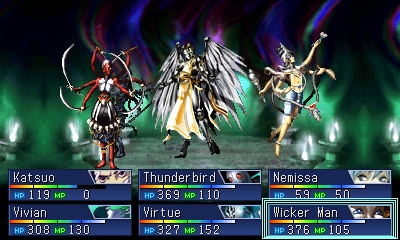 Shall we talk dungeons first? I suppose “dungeons” might not be the correct term, actually. Etrian Odyssey IV (a game also published by Atlus) has dungeons, environments filled with interesting asides, quirks, secrets, traps, hazards. Comparatively speaking, Soul Hacker’s environments are straight-up mazes with the odd puzzle here and there. Where Etrian Odyssey IV invites you to get intimate with its caves, asks you to study them, probe them and fear them, Soul Hackers’ environments feel more frivolous. More “Oops, dead end. Another dead end. Chest, in a dead end. Aha! Door, and a long corridor… And a dead end.” It’s also much easier to save your game, as after a few hours play you can save anywhere.
Shall we talk dungeons first? I suppose “dungeons” might not be the correct term, actually. Etrian Odyssey IV (a game also published by Atlus) has dungeons, environments filled with interesting asides, quirks, secrets, traps, hazards. Comparatively speaking, Soul Hacker’s environments are straight-up mazes with the odd puzzle here and there. Where Etrian Odyssey IV invites you to get intimate with its caves, asks you to study them, probe them and fear them, Soul Hackers’ environments feel more frivolous. More “Oops, dead end. Another dead end. Chest, in a dead end. Aha! Door, and a long corridor… And a dead end.” It’s also much easier to save your game, as after a few hours play you can save anywhere.
Soul Hackers is far more interested in what patrols these corridors: demons. You have two “permanent” members of your group, and these fighters work like traditional RPG units. You level them up through combat, equip them with weapons and armour, and they will always be with you in a fight. If your main character dies, it’s game over, back to the last save, no mulligans.
 The rest of your party is made up of demons. Big ones, small ones, fat ones, thin ones, ugly ones, saucy ones. There are around 300 of the Hell-spawn (with 30 newly added to this 3DS re-release), and working out which ones to summon to compliment your core duo is where it gets interesting. Different demons have different abilities, so you’ll naturally sway towards the archetypes of healer, tank and stat fiddler, but the demons of Shin Megami are not Pokémon. These beasts don’t exist to simply join your ranks and follow your orders. There are no Poké-balls here.
The rest of your party is made up of demons. Big ones, small ones, fat ones, thin ones, ugly ones, saucy ones. There are around 300 of the Hell-spawn (with 30 newly added to this 3DS re-release), and working out which ones to summon to compliment your core duo is where it gets interesting. Different demons have different abilities, so you’ll naturally sway towards the archetypes of healer, tank and stat fiddler, but the demons of Shin Megami are not Pokémon. These beasts don’t exist to simply join your ranks and follow your orders. There are no Poké-balls here.
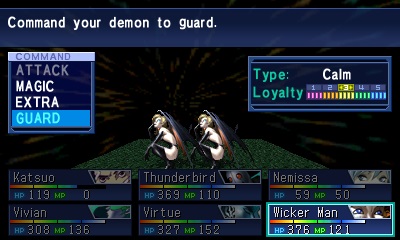 Recall that philosophical sort I mentioned? You can talk to any Demon, and recruiting them in this manner is almost always a puzzling affair. Some might ask a question, some might request items, and others might beg for money. Yet sometimes you’ll give a demon money and then it won’t join you, because giving it the money was a sign of weakness. It’ll keep the dosh though. Sometimes you’ll encounter a monster several times, with each new talk moving the creature closer to your side before they finally join you. Other times you simply need to beat on a creature and then, as you showed it your strength, it will buddy up.
Recall that philosophical sort I mentioned? You can talk to any Demon, and recruiting them in this manner is almost always a puzzling affair. Some might ask a question, some might request items, and others might beg for money. Yet sometimes you’ll give a demon money and then it won’t join you, because giving it the money was a sign of weakness. It’ll keep the dosh though. Sometimes you’ll encounter a monster several times, with each new talk moving the creature closer to your side before they finally join you. Other times you simply need to beat on a creature and then, as you showed it your strength, it will buddy up.
The fact that there is no perfect science to the talk and recruiting functions actually lends Soul Hackers a more extemporaneous flair, making each fight and encounter a unique opportunity. Not to mention that silver tonguing your way out of a potentially fatal fight feels wonderfully liberating in a JRPG.
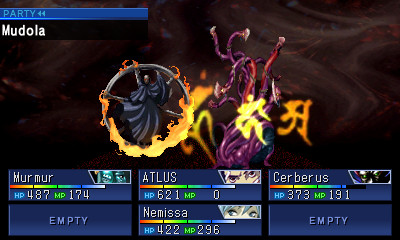 When it comes to the actual brawls, everything is a mite simpler. Using a lane set up, similar again to Etrian Odyssey IV, you can command demons and characters to attack in various ways. Demons need to be trained before they will follow orders 100%, mind, and cycles of the moon can have an effect on their abilities and confidence. How do you train a demon? Well, that depends on the creature in question. Some are actually trained through being given commands but, like I said, Soul Hackers is a game that refuses to work to simple conventions.
When it comes to the actual brawls, everything is a mite simpler. Using a lane set up, similar again to Etrian Odyssey IV, you can command demons and characters to attack in various ways. Demons need to be trained before they will follow orders 100%, mind, and cycles of the moon can have an effect on their abilities and confidence. How do you train a demon? Well, that depends on the creature in question. Some are actually trained through being given commands but, like I said, Soul Hackers is a game that refuses to work to simple conventions.
You can ignore this, of course, and just spam the “go” function to let demons do what they want (and they make pretty good healers, to be fair) and turn your attentions toward party arrangement and composition, but there’s a lot for meticulous players to busy themselves with.
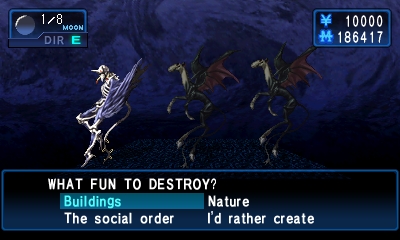 There’s also demon fusing, which is a process that combines two demons into a more powerful beast, but you lose the two demons in the process. Fusing decisions get harder as you find yourself getting unexpectedly attached to the little guys, but it’s a process that is essential as demons don’t level up otherwise. Yet, it’s also fascinating as you’ll want to see what twisted designs come next.
There’s also demon fusing, which is a process that combines two demons into a more powerful beast, but you lose the two demons in the process. Fusing decisions get harder as you find yourself getting unexpectedly attached to the little guys, but it’s a process that is essential as demons don’t level up otherwise. Yet, it’s also fascinating as you’ll want to see what twisted designs come next.
It’s all terrifyingly thoughtful, and it’s the demons’ multi-faceted designs that really sell the combat where the raw mechanics fall short of other games of this ilk. The maze crawling is also helped by demons, as you can’t just keep them summoned, thanks to every “active” demon consuming your “Mag” currency.
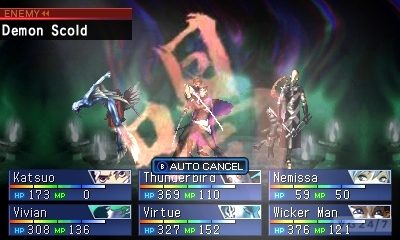 This 3DS version does come up short in a number of areas, but none can undermine the core demon appeal. Two hangovers from its 32-bit origins are that exterior environments have painfully scant draw distances, and pathfinding can be an occasional issue. Visually, it’s also merely alright. Character artwork is gorgeous, but FMVs are somewhat smudged and are rendered in flat 2D, even with the 3D slider notched up, which is just a plain shame.
This 3DS version does come up short in a number of areas, but none can undermine the core demon appeal. Two hangovers from its 32-bit origins are that exterior environments have painfully scant draw distances, and pathfinding can be an occasional issue. Visually, it’s also merely alright. Character artwork is gorgeous, but FMVs are somewhat smudged and are rendered in flat 2D, even with the 3D slider notched up, which is just a plain shame.
The game can also enforce a grind from time to time. It’s all too easy to get flat-lined by a boss because they are just too powerful, prompting a bit of a grind for Mag and extra demons. It’s not huge, but it’s worth knowing that the 30-hour campaign comes with a few speed bumps.
VERDICT: Shin Megami Tensei: Devil Summoner: Soul Hackers is a long, convoluted name for a confounding, deceptive, mischievous, compelling game. The plot is good enough and the characters are entertaining, but it’s the demons, your interactions with them, and the way they embellish the gameplay that helps entice you to explore its maze-like depths. It might not be much of a looker, but when a game takes the time to teach you that impressing a Succubus requires more than merely forced hubris, that absolutely makes it worth investigating.

GOOD. A game that scores 7/10 is worthy of note, but unworthy of fanfare. It does many things well, but only a few of them incredibly well and, despite a handful of good qualities, fresh ideas and solid mechanics, it fails to overwhelm.


